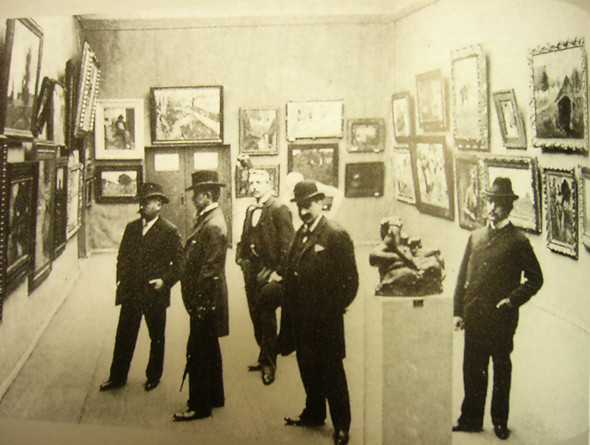













INTRODUCTION | DOCUMENTS | IMAGES | MAPS | EDITOR
|
In the late nineteenth-century, progressive artists in various cities throughout German-speaking Europe began to withdraw – or secede – from official salons, traditional artists’ societies, and art academies to form independent exhibition associations. They did so to protest restrictive exhibition policies, which favored elite artists over their more experimental – and less established – colleagues, to challenge the authority of royal academies and the influence of imperial patrons and conservative taste-makers, and to champion modernist styles such as Impressionism, Naturalism, and Symbolism. By the time sixty-five artists came together to form the Berlin Secession in May 1898, similar groups had already been established in Munich (1892) and Vienna (1897). Under the presidency of the well-known Naturalist and Impressionist artist Max Liebermann (1847-1935) (immediately to the left of the sculpture), the Berlin Secession mounted two shows a year. The photograph below was taken before the opening of the Secession’s second exhibition in the spring of 1900. Along with Liebermann, the artists Walter Leistikow (1865-1908) and Lovis Corinth (1858-1925), and the cousins Bruno (1871-1941) and Paul Cassirer (1871-1926), owners of a Berlin gallery and publishing house, played a key role in the group, which successfully supported avant-garde styles, offering an essential alternative to the “true art” promoted by Wilhelm II: traditional history and landscape paintings and monumental sculptures that glorified both Germany and the Hohenzollerns. Over the course of the Berlin Secession’s fifteen-year history, its membership would include some of the most influential artists of the day. By 1910, however, its commitment to stylistic diversity began to falter, as the group found it increasingly difficult to accommodate the work of a younger, more robust generation of Expressionist artists. That same year, these artists founded their own Secession group – the New Secession – thereby signaling the beginning of the end of the original group.
Source: Renee Price, ed., New Worlds: German and Austrian Art, 1890-1940. New Haven, 2001, p. 135. |
 print version
print version return to image list
return to image list previous image
previous image
